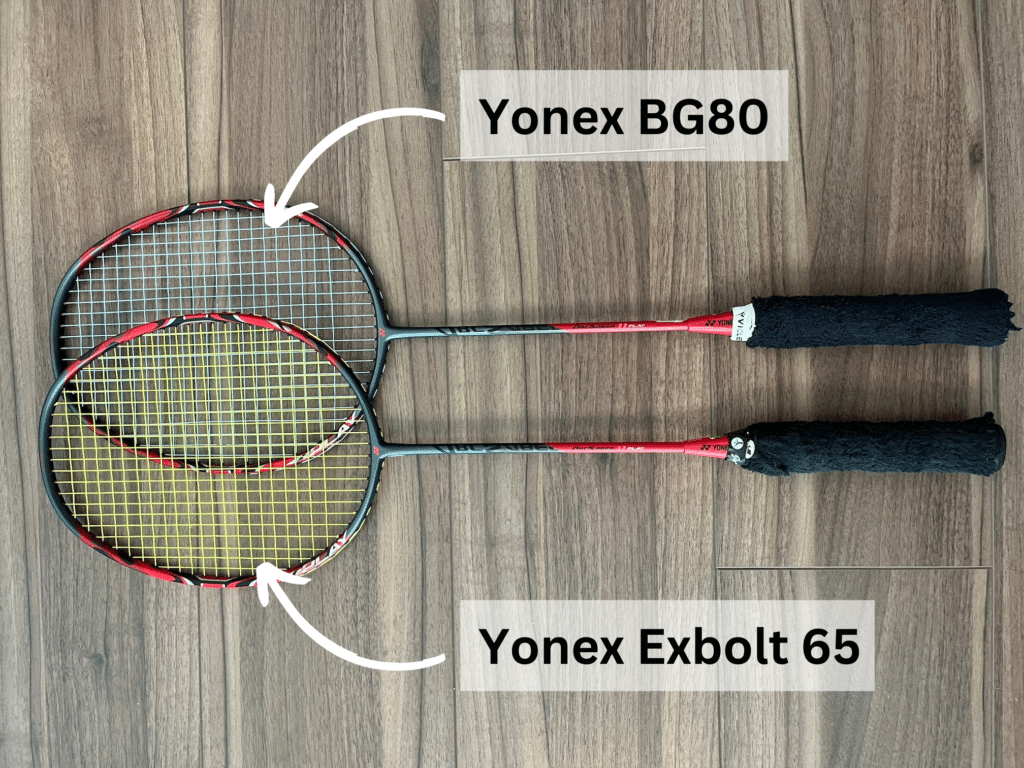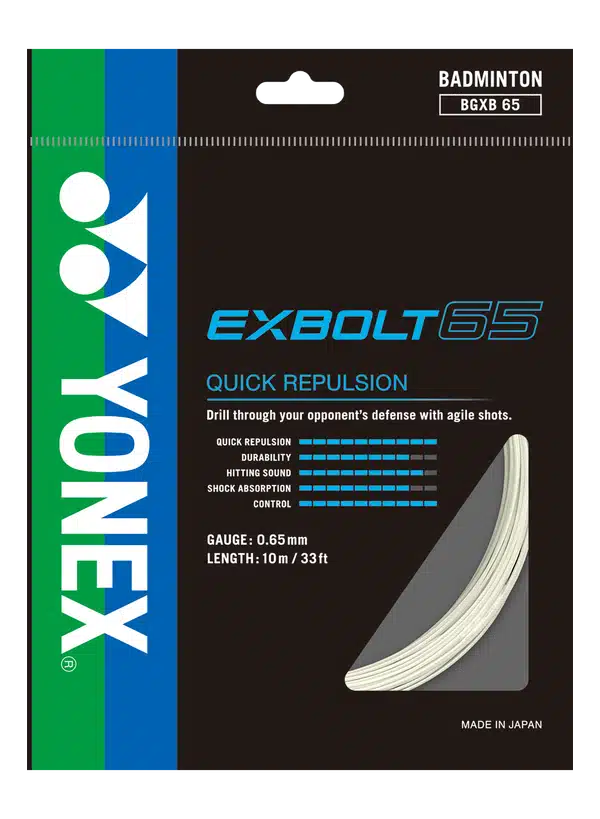Leading up to this Yonex Exbolt 65 review, I’ve noticed many discussions on badminton strings with some even arguing that they are more important than your racket.
I’ve kept a strict habit of playing with the same string during my racket reviews to keep the experience consistent. Now it’s time to explore how big of a difference strings can have on your game.
As a rule of thumb, the more skilled the player, the bigger the difference they make. Strings have a major impact on pro players’ games, but the question is how much it impacts the rest of us.
In this Exbolt 65 review, I’m exploring the string with beginner and intermediate players in mind while comparing it to the popular, classic Yonex BG80. I’ve been playing with the latter for a few years and it deserves its own article, but today it’ll serve as a reference point.
Let’s jump in head first, starting with how I conducted the string test in preparation for this review.
Table of Contents
Yonex Exbolt 65 review (vs Yonex BG80)
In preparation for this Yonex Exbolt 65 review, I went on court for ten hours performing both drills and playing recreational games using two identical Yonex Arcsaber 11 Play (4U) rackets strung at 10.5 kg (23 lbs) string tension. One was strung with my usual BG80 string (sky blue) while the other was strung with the Exbolt 65 in yellow.

String ratings and category
Yonex badminton strings come in three overarching categories: quick repulsion (power), control, and durability.
While both strings are in the quick repulsion (power) category and have slogans that says “Overpowering heavy smash” (BG80) and “Drill through your opponent’s defense with agile shots” (Exbolt 65), I didn’t really know what to make of that as it kinda sounds like the same.
Yonex categorizes the Exbolt 65 as a powerful (repulsive) string with a medium-soft feel in their catalog. That is about as far away from the BG80’s hard feel as you can get within the repulsive power category, so I was curious to understand what it would do for my game.
As an easier reference point, here’s a screenshot of the string matrix in the current Yonex gear catalog (arrows are my own).

Next, let’s look at how Yonex rates these two strings head-to-head before diving into my experience playing with them.
| Metrics | Yonex Exbolt 65 | Yonex BG80 |
|---|---|---|
| Repulsion Power | 10 | 8 |
| Durability | 8 | 6 |
| Hitting Sound | 9 | 7 |
| Shock Absorption | 8 | 6 |
| Control | 10 | 6 |


As you can see, there isn’t much to say about Yonex’s ratings, except they suggest that the Exbolt 65 has 20% more power (repulsion), which is a fair bit. They also suggest a near-perfect score for the Exbolt 65 across the board.
That seems to suggest that there’s no downside to this string which must be too good to be true. With that in mind, let’s dive into my on court experience testing the Exbolt 65 and BG80 on court.
My review (how it felt to play with these strings)
At first, these two strings appeared similar and I found it hard to tell the difference during smashing, smash blocks, and clears.
On drop shots, I immediately noticed getting more power with the Exbolt 65, resulting in less tight shots until I had adjusted my technique. On the other hand, I felt slightly more control and less power with the BG80 string.
The Exbolt 65 also gave me a nice boost in power on my poor backhand shots. Especially on difficult “hail mary” retrievals where you’re so late to the shuttle that your only chance is playing a backhand drop and hoping you can still whip it over the net.
The more I played with both strings, the more I noticed extra power on all my shots with the Exbolt 65 provided I’d hit the shuttle cleanly.
It felt more challenging to get a clean hit with that string, but nicer once it happened. That suggests a smaller sweet spot, which requires better stroke technique to take advantage of consistently. When I didn’t hit it cleanly, it felt as if the racket or strings vibrated at times and that I was at the mercy of the badminton gods on overhead strokes.
On the other hand, the Yonex BG80 string felt slightly less demanding, but also less fun and with a less crisp sound.
Overall, the Exbolt 65 has a nicer and crisper sound while giving that extra bit of power resulting in shots traveling slightly further than with the BG80.
The trade-off is that the sweet spot feels slightly smaller, meaning that it’s less forgiving if you don’t make clean contact with the shuttle.
In terms of durability, the Yonex BG80 begins to sound slightly dull rather quickly, but I haven’t noticed much difference in performance even after a few months of playing with it. It seems to keep the tension well.
I can’t comment on the longevity of the Yonex Exbolt 65 string just yet, but after playing with it for a month or so, it seems to hold up just fine so far.
The biggest struggle for me was noticing the difference in feel.
Since we beginner and intermediate players tend to play with lower string tension, the hard and soft feeling of strings can be difficult to tell apart.
In fact, during this string test, I was struggling to notice any difference between the harder and medium-soft feel between these two. Rather than giving you some random theory of why, I’ll get straight to the point: that you’re unlikely to notice any difference in feel, too.
Yonex Exbolt 65: the verdict
The Exbolt 65 is a thinner string at 0.65 mm as opposed to BG80’s 0.68 mm, which I understand makes it more difficult to play with and thus less suitable for beginner players and intermediates who don’t drill stroke technique regularly. Thinner strings also tend to break more easily, especially if you don’t hit the shuttle cleanly that often.
That’s a shame because it felt more fun to play with and I found myself reaching for the racket with that string more often during my tests.
You probably won’t notice much of a difference if you’re a beginner, but you’ll risk more mishits in exchange for fewer, better shots until your technique is better. It’s not worth the trade off just yet, unless you’re working hard to level up your stroke technique.
Beginner and intermediate players only considering these two strings are better off using Yonex’s BG80. It’s easier to win games with mediocre shots that go back over the net rather than all-or-nothing shots that’ll cause a fault or a winner outright.
4 comments
Hi, thank you for the very nice expertise! possible text bg66 ultimax and bg 80 power please.
=) thank you for your website, I love it.
(translated text I am French)
Thanks for the kind words, Thomas. I’ll put those strings on the list 🙂
This is a nice post. Anyway, I’d like to share some of my experiences with Exbolt 65. For me, the Ex65 is a hard feeling string (strung tension 24 lbs Astrox 70), I have to lower the tension as it keeps bouncing off my racket. I can feel the vibrations especially during drives. At first, I thought maybe my arm muscles are just weak but whenever I play with 66 UM there’s none. So what’s the explanation for that, I don’t know. You’re right as this is not a beginner strings. It’s very hard to use even with low tension. I also tried the Ex63, surprisingly, it’s a lot better than 65. Whenever the 66 UM is not available in my local store, my alternative is the Ex63. I haven’t tried the BG80, though I’m surprised you said this is a beginner friendly string.
Hey Michelle, thanks for sharing your experience.
To clarify, I meant that among these two strings, the BG80 is the more beginner friendly choice (not that it is a beginner friendly string). I have updated this for clarity.